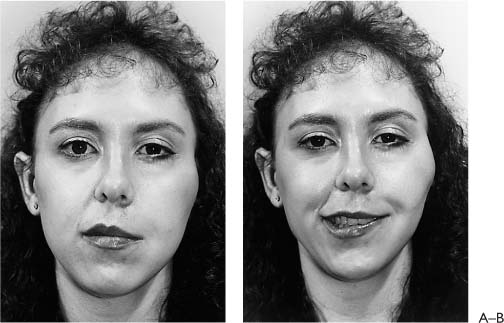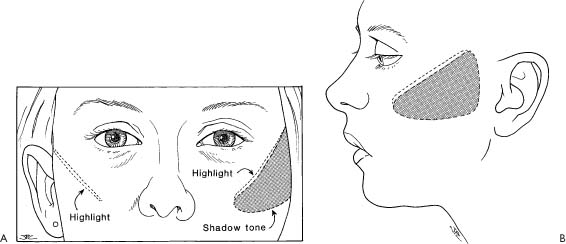9 The patient and surgeon realize that even the best postoperative result will be an approximation of balance between the paralyzed and unaffected sides of the face. This said, there are quite a number of steps one can take to further enhance appearance. Should the patient wish to pursue further modifications, there are many techniques available. These will be described so the appropriate options may be considered by the patient. Corrective techniques for males and females will be discussed separately. While there are certain measures that both may employ, there are others which are genderspecific. A summary of physical characteristics of the paralyzed face and the steps which may improve them is provided in Table 9-1. It should be emphasized that each patient is unique and will have a different combination of these characteristics. Further, even these may change with time. There are a number of sources available for the patient to consult for nonsurgical enhancement of facial appearance. These include hair stylists, barbers, cosmetologists, opticians, and prosthodontists. Their professional advise can help customize the recommendations made below. A detailed analysis of individual patients and appropriate recommendations are available through the Shadyside Hospital Facial Paralysis Center*. Because females have more options that they will consider acceptable, their opportunities will be discussed first. Bear in mind that these are generalized suggestions. They should be amended as necessary based on the individual patient’s features.
Enhancing Facial Appearance with Cosmetic Camouflage
Jon P. Coulter, C.M.I., and Mark May, M.D.
| Characteristics | Male Options | Female Options |
| 1. Lack of forehead wrinkling |
|
|
| 2. Temporalis muscle bulge |
|
|
| 3. Asymmetrical eyes |
|
|
| 4. Drooping brow |
|
|
| 5. Nasal collapse and curvature |
|
|
| 6. Irregular lip conformation |
|
|
| 7. Paralyzed lips thinner than unaffected side |
|
|
| 8. Features surgically removed |
|
|
Techniques for Females
Hairstyling
Hairstyles are of infinite variety and subject to the constantly changing demands of time and fashion. Nevertheless, it is possible to discuss certain concepts that are timeless. It is recommended that the patient try to achieve what stylists describe as a sense of “movement.” A static look will draw undue attention to any imbalance in the face.
Hair should be kept looking soft. Feathering and layering up will help achieve this. Hair should be bobbed and be midlength or shorter. Styles that depend on perfect symmetry and geometric edges such as the “page boy” must be avoided. They will only exaggerate the differences between the two halves of the face. They are demanding enough on nonparalyzed features. When coloring hair, it is best to use subdued rather than bright hues. A soft blond is preferable to a bright yellow-blond. Auburn is a better choice that “carrot” red. A mid to light brown color would be more appropriate than a deep brown.
There are three distinctive facial characteristics of hemifacial paralysis that a becoming hairstyle can address. These are lack of forehead wrinkling on the paralyzed side, size differentials between the two eyes, and bulging of the cheek when a temporalis muscle slip has been directed over the zygomatic arch (see Chapter 4).
Loss of muscle tone on the paralyzed side eliminates forehead wrinkling. The patient may not consider this a problem because it is scarcely noticeable at rest. An unusual appearance may result during an animated conversation or when expressing doubt or surprise (Fig. 9-1A). If this is bothersome to the patient, it is easily managed through the use of bangs (Fig. 9-1B). Other facial features, however, may necessitate a less regular cut than the one shown here.
Treatment of the differing eye sizes is a more complicated issue. Although the paralyzed eye is usually the larger-appearing eye due to nerve loss in the eyelid muscles, the situation may change with time. Should the patient undergo a gold or spring implant described in Chapter 6, or following faulty regeneration, the affected eye may become the smaller of the two (Fig. 9-2). The imbalance may be minimized by creating the impression that the smaller eye is larger than it is. To accomplish this, a pivot point should be made above the smaller eye (Figs. 9-3A,B). By expanding the forehead exposure on this side, the smaller eye will appear larger. The larger eye will be de-emphasized by the downward sweeping hair which should cross the eyebrow and approach the eye itself. Any hair approaching the smaller eye should be trimmed above the eyebrow. A variation on this style is seen in Figure 9-3C.
When present, the temporalis sling bulge may be the most distracting feature of the female patient (Figs. 9-2A,B). To minimize the bulkiness of the cheek, the hair can be swept forward to cover both the ear and the cheek (Fig. 9-4). This should be done on both sides. This hair style will also mask the loss of an ear, as may be experienced during surgery for certain tumors. The patient may wish to cultivate an exotic style that advances the hair over the paralyzed side only. This may be dramatic, but necessitates longer hair than is advisable. The more natural look is recommended.
The fullness, thickness, amount of curl, and quantity of the patient’s hair will affect the types of hairstyles attainable. If the suggestions made cannot be followed due to nature’s limitations, hairpieces and wigs may be employed. These should be styled along the lines discussed.
Corrective Makeup
The affects created through hairstyling can be enhanced even more with proper makeup. These involve the applications of products with which most women are already familiar. With a little practice, all of the techniques to be described can be easily performed by the patient herself.
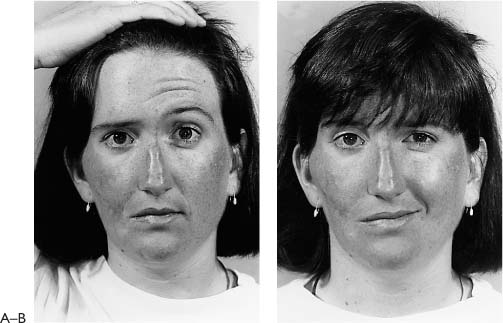
Figure 9-1. Lack of forehead wrinkling on paralyzed side. Bangs covering forehead.
Figure 9-2. Patient with left facial paralysis post-resection osseous hemangioma reanimated with temporalis muscle transposition and closed-eyelid spring. Distracting bulge caused by temporalis sling technique and narrowed left eye from eyelid spring. A, Patient at rest. B, Patient smiling.
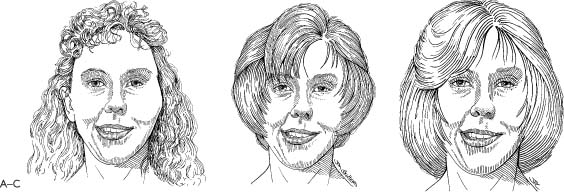
Figure 9-3. A, Tracing of patient in Figure 9-2B. B, Pivot point in hair above smaller eye. C, Variation in hairstyle showing many possibilities exist within recommended parameters.
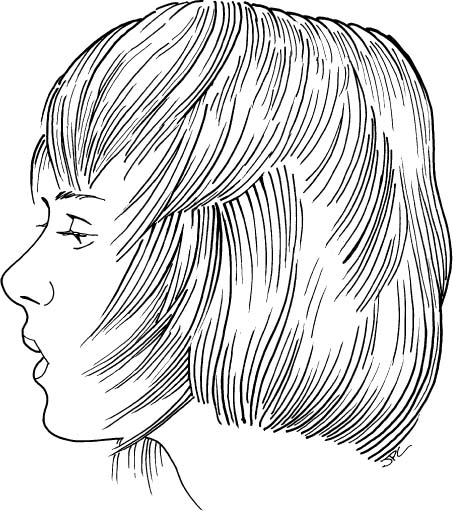
Figure 9-4. Profile view of forwardsweeping hairstyle designed to cover temporalis bulge in patient illustrated in Figure 9-2.
Figure 9-5. A, Frontal view of makeup technique to reduce apparent mass of temporalis bulge. A shadow tone is placed across the mass of the bulge as indicated. A highlight is placed along the top edge of the shadow. A matching highlight is applied to the cheek that is not paralyzed. No shadow should be placed on this side as it would undo the effect created by shading the temporalis bulge. B, Profile view.
Corrective makeup helps to enhance the better facial features and downplay the results of injury and/or surgery. As a general rule, features can be accented with proper highlighting and subdued with the appropriate shadowing or shading.
A highlight results when a shade lighter than the original foundation is applied to a particular part of the face. Correct use of highlights brings out the features to be emphasized. A shadow is produced when a tone darker than the original foundation is used. Shadows minimize prominent or detracting features, making them less noticeable.
Stay updated, free articles. Join our Telegram channel

Full access? Get Clinical Tree


